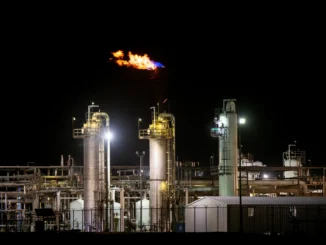
In the heart of Canada’s oil country, a provocative idea is simmering: What if Alberta, the powerhouse of North American energy production, held a referendum to secede from Canada and join the United States as the 51st state? Recent developments, including Alberta’s new referendum rules that lower the threshold for citizen-initiated votes, have fueled speculation and petitions pushing for sovereignty.
Separatist groups like Alberta Next and the Alberta 51 Project are gaining visibility, with some explicitly advocating for U.S. annexation amid frustrations over federal policies stifling the oil and gas sector.
Alberta’s Economy: Oil and Gas Dominance with Emerging Diversification
Alberta’s economy is synonymous with energy. In 2019, the oil sector alone contributed over CAD 68 billion to the province’s GDP, and by 2023, capital spending in energy hit $30 billion, making it the primary driver of private investment.
The province’s oil sands and natural gas reserves have long been the backbone, but volatility in global prices—exacerbated by potential U.S. tariffs and trade wars—poses risks.
A long-term decline in the sector is projected to begin by the end of the decade, driven by global shifts toward renewables.
Yet, Alberta isn’t a one-trick pony. Efforts to diversify are underway, with sectors like agribusiness, life sciences, construction, high-tech, health care research, international education, manufacturing, cleantech, renewable energy, agriculture, and artificial intelligence showing promise.
For instance, agribusiness and life sciences have thousands of job vacancies, while cleantech and AI attract investment opportunities.
None of these can fully replace oil’s 25% share of GDP yet, but they represent a buffer against energy market fluctuations.
In a U.S. statehood scenario, access to the vast American market could accelerate growth in these areas, potentially boosting exports and innovation without federal Canadian hurdles.
The Financial Reality: From Net Contributor to U.S. Taxpayer
Historically, Alberta has been Canada’s fiscal heavyweight, often giving far more to the federal government than it receives back. From 2007 to 2022, Albertans contributed a net $244.6 billion more in revenues to Ottawa than they got in spending and transfers—averaging about $16 billion annually.
Over a longer horizon, from 1961 to 2019, the net contribution swells to $622 billion, roughly 5% of the province’s economic activity.
The oil and gas sector alone funneled $53 billion to federal coffers in recent years, with annual contributions ranging from $2.5 billion to $3.7 billion.
Critics argue this is “dirty money” with little reciprocity, as federal policies like carbon taxes and pipeline restrictions hinder Alberta’s core industry while funding programs elsewhere.
In 2018, Alberta was the largest per capita net contributor due to its high incomes and young population.
If Alberta became a U.S. state, this dynamic flips. Instead of subsidizing Canada, it would pay into the U.S. federal system, potentially facing lower corporate taxes (U.S. federal rate at 21% vs. Canada’s combined rates often higher) and gaining access to a $31 trillion integrated economy.
Hypothetical analyses suggest benefits like streamlined cross-border pipelines, reduced regulatory burdens on energy, and direct U.S. market access for oil exports.
However, drawbacks include losing Canada’s universal healthcare (replaced by a U.S.-style system, potentially raising costs for residents) and adapting to U.S. social programs, which could strain lower-income Albertans.
Alberta’s GDP per capita—already high—might grow further, but landlocked status could complicate trade unless U.S. integration eases it.
|
Aspect
|
Current (Canadian Province)
|
Hypothetical (U.S. State)
|
|---|---|---|
|
Net Federal Contributions
|
$244.6B outflow (2007-2022)
|
Inflows from U.S. infrastructure/investments; outflows to U.S. taxes
|
|
Energy Sector Impact
|
Federal restrictions on pipelines/oil
|
Easier U.S. approvals, larger market access
|
|
Tax Burden
|
High provincial/federal combo
|
Potentially lower U.S. federal rates
|
|
Social Services
|
Universal healthcare, EI
|
U.S.-style insurance, possible cost hikes
|
|
Market Access
|
Canadian + international
|
Full U.S. domestic market ($25T+ GDP)
|
Canada’s Energy Mix
Primary Energy Consumption Mix
Canada’s total primary energy supply (TES) in 2023 was dominated by fossil fuels, reflecting its role as a major oil and gas producer and exporter. According to the International Energy Agency (IEA) and Canadian Centre for Energy Information:
- Oil: Approximately 34% of TES, primarily used in transportation (e.g., gasoline, diesel) and industry.
- Natural Gas: About 30%, key for industrial processes (including oil sands extraction), heating, and power generation.
- Hydroelectricity: Around 7%, mainly converted to electricity.
- Nuclear: Roughly 6%, also for electricity.
- Coal: About 5%, declining due to phase-outs in power generation.
- Renewables (wind, solar, biomass, etc.): 12-15%, including biofuels for transport and non-hydro renewables for electricity.
- Other: Minimal, including imports and minor sources.
This mix has shifted slightly toward renewables over the past decade, but fossil fuels still account for over 70% of primary energy due to high demand in transport and industry. Per capita energy consumption is high at around 300 GJ/person annually, driven by cold climates and resource extraction.
In 2023, end-use demand totaled about 11,059 PJ, with the industrial sector consuming 53%, transportation 20%, residential 14%, and commercial 13%.
|
Source
|
Share of Primary Energy (%)
|
Main Uses
|
|---|---|---|
|
Oil
|
34
|
Transport, industry
|
|
Natural Gas
|
30
|
Heating, industry, power
|
|
Hydro
|
7
|
Electricity
|
|
Nuclear
|
6
|
Electricity
|
|
Coal
|
5
|
Power (declining)
|
|
Renewables (non-hydro)
|
12-15
|
Power, biofuels
|
|
Other
|
<5
|
Imports, minor
|
Electricity Generation Mix
Canada’s electricity is among the cleanest globally, with 82% from non-GHG-emitting sources in 2022-2024. Total generation was 639 TWh in 2022 and around 625-640 TWh in 2023.
Hydropower dominates, supported by nuclear and growing wind/solar. Fossil fuels (mainly gas) fill gaps, especially in Alberta and Saskatchewan.
- Hydro: 55-62% (largest source, e.g., Quebec and British Columbia rely heavily on it).
- Nuclear: 13-14% (primarily in Ontario).
- Wind: ~7%.
- Solar: ~1-1.5%.
- Natural Gas: 16% (increasing as coal phases out).
- Coal: 4% (phasing out by 2030).
- Biofuels/Other Renewables: ~2%.
Emissions intensity for electricity is low at ~470 g CO2e/kWh in Alberta (higher due to gas/coal) but nationally much lower.
Per capita electricity consumption was 14.6 MWh in 2020, with industrial use dominant.
|
Source
|
Share of Electricity (%)
|
Key Provinces
|
|---|---|---|
|
Hydro
|
55-62
|
Quebec, BC, Manitoba
|
|
Nuclear
|
13-14
|
Ontario
|
|
Wind
|
7
|
Alberta, Ontario
|
|
Solar
|
1-1.5
|
Ontario, Alberta
|
|
Natural Gas
|
16
|
Alberta, Saskatchewan
|
|
Coal
|
4
|
Alberta (phasing out)
|
|
Biofuels/Other
|
2
|
Various
|
Canada aims for 72% renewable electricity by 2030 and net-zero emissions by 2050, with policies like carbon pricing accelerating the shift from coal to gas and renewables.
Oil and Gas Production in AlbertaAlberta is Canada’s energy powerhouse, producing 84% of the nation’s crude oil and 61% of its natural gas in 2023.
Production hit records amid global demand and preparations for the Trans Mountain Pipeline expansion.
Crude Oil Production
In 2023, Alberta produced an average of 4.3 million barrels per day (MMb/d) of crude oil (including condensate and pentanes plus), up from 3.8 MMb/d in the first 11 months (annualized record).
This marked a 1.4% increase nationally, but Alberta drove most growth.
- Oil Sands: 3.4 MMb/d of raw bitumen (78% of total), with 1.2 MMb/d upgraded to synthetic crude oil (SCO).
- Conventional: 0.5-0.6 MMb/d (light: 374 Mb/d, heavy: 145 Mb/d).
- Total annual volume: Approximately 1.57 billion barrels.
Production peaked at 4.19 MMb/d in December 2023, the first time exceeding 4 MMb/d monthly.
Oil sands (in situ and mining) dominate, with key operators like Cenovus (175 million barrels annually) and Canadian Natural Resources (148 million barrels).
Forecasts predict a peak of ~4.6 MMb/d by 2027 before slight declines.
Natural Gas Production
Alberta produced an average of 10.9 billion cubic feet per day (Bcf/d) of marketable natural gas in 2023, a 0.8% increase from 2022 and 61% of Canada’s total.
- Total annual volume: About 3.98 trillion cubic feet.
- Sources: Primarily tight and shale gas (e.g., Montney Formation), with declines in coalbed methane.
- Demand: 6.9 Bcf/d consumed in Alberta (58% industrial, including oil sands).
Production rose to 11.2 Bcf/d in 2024 but was 10.9 Bcf/d in 2023.
Growth is driven by liquids-rich plays, with forecasts to 11.6 Bcf/d by 2033.
Alberta’s reserves: 372 trillion cubic feet remaining.
Advantages: U.S. Military Protection and Strategic Security
One clear upside for Alberta: trading Canada’s modest military for the world’s most powerful. As a U.S. state, Alberta would fall under the full umbrella of American defense, including NATO commitments and advanced infrastructure.
This means protection from external threats without the current reliance on a Canadian military often criticized for underfunding. Separatists highlight benefits like Second Amendment rights and stronger alliances against global energy rivals.
In an era of trade wars and geopolitical tensions, U.S. military backing could safeguard Alberta’s oil infrastructure, deterring embargoes or disruptions.
Ripple Effects on NATOAlberta’s secession wouldn’t directly upend NATO, as both Canada and the U.S. are members. However, it could strain alliance dynamics by redrawing North American borders, potentially complicating joint operations and intelligence sharing.
Historical precedents, like Quebec separatism discussions, suggest minimal military fallout, but Alberta’s energy resources might prompt NATO to view it as a strategic U.S. gain, indirectly bolstering the alliance’s North American footprint.
Tensions could arise if Canada contests the move legally, but NATO’s focus on collective defense would likely adapt.Impacts on Canada’s Budgets and Energy SecurityCanada would face a massive fiscal hit. Alberta’s departure means losing a key net contributor, creating a $20-47 billion annual hole in federal revenues (based on recent averages).
Equalization payments and transfers—where Alberta funds “have-not” provinces—would need reconfiguration, potentially raising taxes elsewhere or cutting services.
Energy security takes a bigger blow: Alberta produces the bulk of Canada’s oil, so secession could force reliance on imports, spiking prices and vulnerability to global shocks.
Pipelines like Trans Mountain might face disputes, and environmental policies could falter without Alberta’s royalties subsidizing green initiatives.
Overall, Canada’s GDP could shrink by 10-15%, with eastern provinces hit hardest.
The Bottom Line:
While Alberta’s push to become the 51st state is fueled by energy frustrations and fiscal grievances, the financial reality is a double-edged sword: liberation from Canadian outflows but adaptation to U.S. systems. For energy stakeholders, it could mean boom times in a pro-fossil fuel U.S., but at the cost of national unity and security shifts. As petitions circulate and referendums loom, the debate underscores Alberta’s pivotal role in North America’s energy future.






